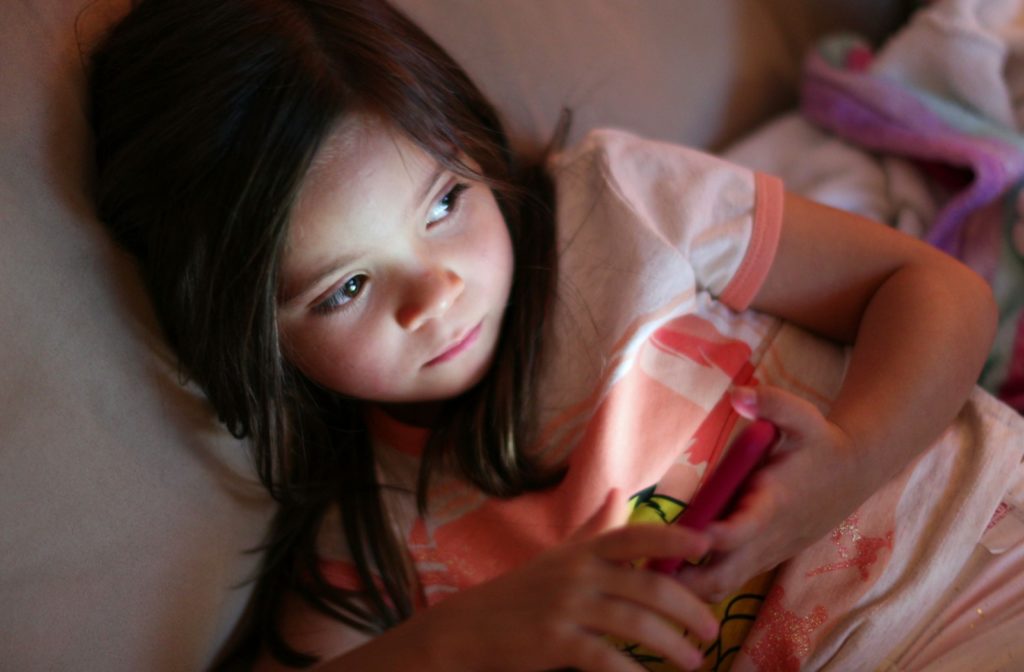In today’s digital age, the prevalence of screens in our daily lives, particularly among children, has sparked growing concerns about their impact on eye health.
With the widespread use of smartphones, tablets, and computers, parents and optometrists are increasingly worried about the potential harm to young, developing eyes. Some common side effects of excessive screen time in kids includes:
- Digital eye strain and discomfort
- Dry eyes
- Increased risk of myopia (nearsightedness)
- Disrupted sleep patterns
Can Screen Time Damage Children’s Eyes?
The digital age has transformed the way children learn, play, and interact with the world around them. However, this shift has introduced the question of whether screen time can cause lasting damage to their eyes.
Research suggests that excessive and improper use can lead to uncomfortable symptoms and potentially exacerbate underlying eye conditions.
Digital Eye Strain & Discomfort
Digital eye strain or Computer Vision Syndrome (CVS) encompasses a range of eye and vision-related problems resulting from prolonged computer, tablet, smartphone, and other digital device use.
Symptoms include eye strain, headaches, blurred vision, dry eyes, and neck and shoulder pain. In children, these symptoms can affect academic performance and general well-being.
Several factors contribute to eye strain, including:
- Poor lighting
- Glare from screens
- Improper screen distances
- Infrequent screen breaks
When children spend extended periods focusing on digital devices without rest, their eye muscles can become fatigued, leading to visual discomfort.
Dry Eyes
When kids stare at screens for a long time without blinking enough, their eyes don’t get the moisture they need. Normally, humans blink about 15 times a minute, but when we’re focused on screens, that rate drops a lot.
So, it’s like your child’s eyes aren’t getting the drink of water they need, and they end up feeling dry and scratchy. Plus, the blue light from screens can make their eyes produce fewer tears, which makes the dryness even worse which can result in dry eyes.
Increased Risk of Myopia
Myopia, or nearsightedness, is a condition where distant objects appear blurry while close ones are seen clearly. There’s a growing body of evidence suggesting that excessive screen time can play a significant role in the development of myopia in children.
When kids spend a large amount of time focusing on screens at a close distance, it can put a strain on their eyes, potentially leading to the elongation of the eyeball, which is the primary cause of myopia.

Disrupted Sleep Patterns
Excessive screen time, especially before bedtime, can significantly disrupt children’s sleep patterns. The blue light emitted by screens of digital devices is known to inhibit the production of melatonin, a hormone that regulates sleep-wake cycles.
Now, imagine this happening night after night. It’s like a domino effect: delayed sleep onset leads to less shut-eye overall, which can leave kids feeling cranky, groggy, and out of sorts during the day. Not to mention, it can mess with their ability to concentrate, learn, and solve problems.
That’s why parents and caregivers must set some boundaries around screen time, especially in the hours leading up to bedtime.
Creating a tech-free wind-down routine—think reading books, doing calming activities, or simply chatting about the day—can help kids ease into sleep more smoothly and wake up feeling refreshed and ready to tackle the day.
Recommended Screen Time by Age
The Canadian Paediatric Society recommends:
- For children under 2 years old: screen time is not recommended.
- For children 2 to 5 years old: limit screen time to 1 hour a day or less.
- For children 5 to 12: limit screen time to 2 hours a day or less.
Strategies to Keep Your Child’s Eyes Healthier
Given the challenges that excessive screen time presents to children’s eye health, parents and caregivers need to adopt strategies that reduce these risks. Here are some steps you can take to preserve and protect your child’s vision:
- Follow the 20-20-20 Rule: Encourage your child to take a 20-second break to look at something 20 feet away every 20 minutes. This simple practice helps relax the eye muscles and reduce eye strain.
- Ensure Proper Lighting: Reduce glare and eye strain by making sure the room is well-lit while your child uses a screen. Avoid positioning the screen directly in front of a window or bright source of light.
- Adjust Screen Settings: Adjust the brightness, contrast, and font size on the device to comfortable levels to minimize eye strain. Many devices also offer blue light filters or night modes to reduce blue light exposure.
- Promote Blinking: Remind your child to blink regularly when using screens to prevent dry eyes. This natural action refreshes the eyes but tends to lessen with concentrated screen activities.
- Set Limits on Screen Time: Establish clear guidelines for how much time your child can spend on devices each day. Encourage breaks and alternative activities that don’t involve screens.
- Encourage Outdoor Play: Increase the time your child spends outdoors. Outdoor activities not only offer a break from screens but also expose children’s eyes to natural light, which can help prevent myopia.
- Schedule Regular Eye Exams: Regular eye check-ups can help catch any eye problems early. An optometrist can provide personalized advice for protecting your child’s eye health based on their individual needs.
While digital screens have become intricate components of modern life and learning, it’s essential to be mindful of their use, especially among children. It’s also important to schedule regular eye exams for your child.
At Trinity Hills Eyecare, we can assess your child’s vision health and provide personalized recommendations to mitigate any potential issues caused by screen time.
Don’t wait until there’s a problem—schedule an appointment today to ensure your child’s eyes stay healthy and strong!



